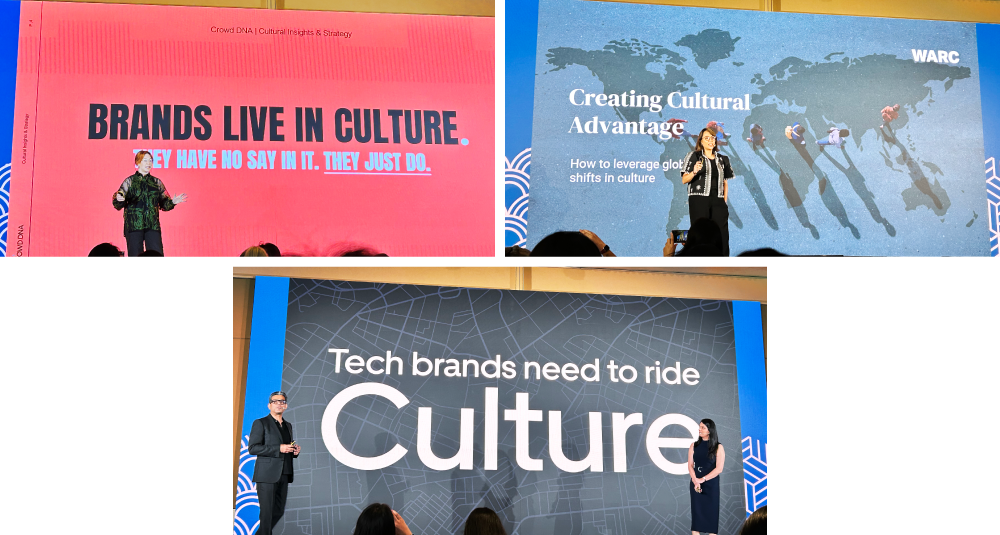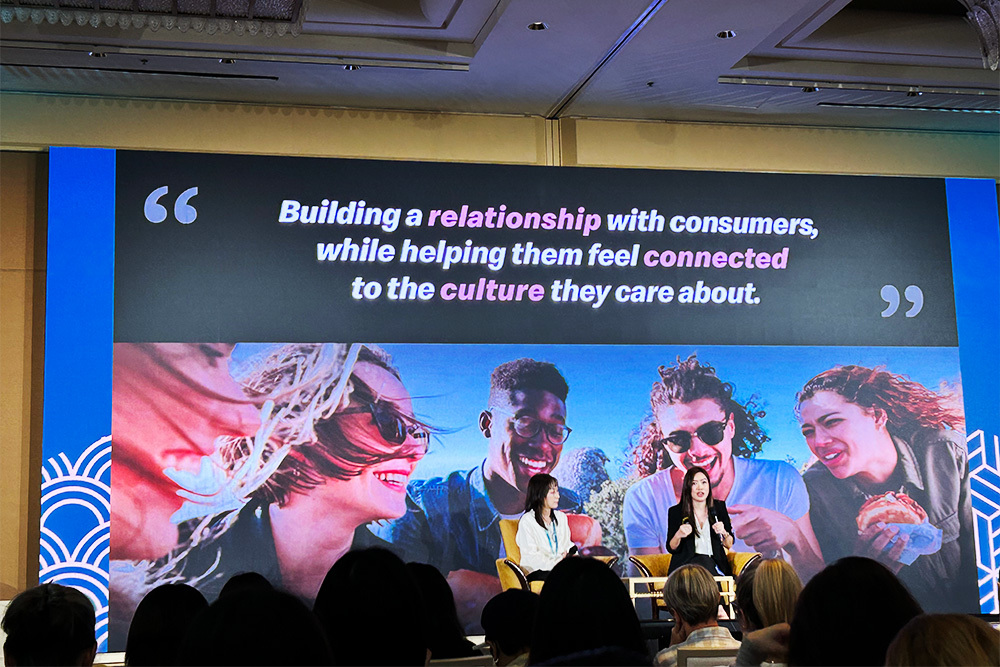Hello, I'm Kana Nakamura from Dentsu Inc.'s Global Business Center. I visited the Spikes Asia festival, Asia's largest communications festival held in Singapore in March 2024. As a strategic planner with no experience in creative departments and attending an advertising awards festival for the first time, I report honestly on what I saw and felt in vibrant Singapore.
A Return to Understanding Local Culture, Seen Through the Seminars
What struck me first was how frequently the word "Culture" was emphasized throughout the seminars, regardless of the speaker or topic. I had expected seminars to focus most on the latest trends like technology, so this was unexpected.

Speakers Focusing on Culture
"Seminar: How to Respond to Global Shifts in Culture" (top left) "Seminar: Creating Cultural Advantage in Asia" (top right) "Seminar: How Brands Can Win India by Tapping into Culture" (bottom)
This year also saw a change in specifications: entries were required to explain the cultural context behind their ideas at the submission stage. This additional requirement appears to have been added so that international judges could better understand the reasoning behind the idea and its significance when evaluating entries.
There has long been debate about whether the ideas winning advertising awards are truly the same as those that generate buzz and function effectively in their target regions. While the excellence of the output is a given, the argument goes that ideas with clear objectives and low-context appeal—those easily understood by people from different cultures—tend to be more globally valued.
In contrast, there has been a growing sentiment that precisely because we live in an era where goods and information flow seamlessly and global standards are established across all fields, the fundamental premise of creativity should not be chasing global trends. Instead, ideas that strike a chord with local people and galvanize communities should be valued.
The intention that ideas rooted in local culture should be valued in the global arena of creativity may also be embedded in the addition of the explanatory items mentioned earlier.
Each speaker at the seminar also addressed a common challenge: when expanding brands across culturally diverse Asian nations, the key lies in how to understand and immerse oneself in the local culture.
Ada Lazaro, Regional Marketing Director for McDonald's Asia Business Unit, commented, "It's not enough for a brand name to be merely known. It must naturally arise in everyday conversation, build strong relationships with consumers, and become part of them." Her point that "McDonald's running a great ad during the Super Bowl and creating a space where viewers are watching isn't culture. Only when a space naturally emerges where viewers are watching the game with a hamburger in hand can you say it has become part of the culture" resonated deeply with the audience, who nodded in agreement.

"Seminar: How McDonald’s Culturally Connects to Gen Z by Riding the K-Wave"
Additionally, Phoebe Shen, General Manager at Chinese PR agency Ruder Finn Thunder, made a very memorable comment on what it means to operate globally: "If a company only employs Chinese staff when expanding overseas, it remains a Chinese company abroad. Only by welcoming local employees, integrating with local culture, and taking root locally can it truly be called a global company."
A recurring theme throughout the seminar was a return to understanding "Local Culture." Meanwhile, the Australian campaign "FITCHIX," which won the Grand Prix in five categories, Gold in five categories, and Silver in two categories, was remarkable for its excellent insight and integrated campaign design. Yet, its challenges and solutions felt clear, presenting an idea that seemed scalable to any country or region. Perhaps we are currently in a transitional phase where ideas deeply rooted in local challenges and solutions are gradually gaining global recognition.
The Democratization of AI and the Human Touch We Must Cherish
Another frequent topic at the seminars was, unsurprisingly, technology and data. This year, generative AI was particularly in the spotlight.
Each seminar approached the topic from two distinct perspectives: how brands and agencies will coexist with generative AI in their future operations, and how generative AI will impact creativity and ideas moving forward.
Regarding the former, all agency representatives speaking on AI-related themes agreed that it should be embraced aggressively for efficiency gains. With AI's reasoning accuracy improving exponentially and free AI tools proliferating—driving AI democratization—there's no path forward that avoids engaging with AI. Speakers enthusiastically shared how they're using ChatGPT to reduce time spent on tasks like information gathering, freeing up more time for strategic thinking.
With AI becoming a standard presence in our environment, it seems a waste to dismiss it as some mysterious entity that might surpass humans and then shut it out of fear. The key lies in knowing where and how to use it. It made me pause and reconsider: the real threat isn't AI itself, but the growing gap between those who master AI and those who don't.

"Seminar: Be Fearless in the Face of AI"
Regarding the latter perspective—the impact on future creativity—we agreed on a positive view: incorporating AI and technology is merely one tool among many. The value of AI's advancement lies not in the ideas themselves, but in its effectiveness as a means to broaden the possibilities of output.
On the other hand, even if an output is novel or cutting-edge, what truly matters is: "Why is this idea needed?", "What can creativity do to help humans live rich, human lives?", and "How can we incorporate AI and technology as a means to communicate this?"
The magic of this synergy is the key going forward, and it is ultimately humans who must perform this synergy. This seemed to be the message conveyed throughout this year's Spikes Asia.
Amidst diverse cultures crossing borders and intermingling, and as technological evolution diversifies solutions, we must discern what truly needs to be achieved and create ideas accordingly. Precisely because we live in an era where new methods are constantly emerging and the very structure of how things are created is changing, I felt there is meaning in strategic planners participating in the creative process. This is to uphold the fundamental premise of universal marketing: understanding for whom the idea exists and what it can achieve.







